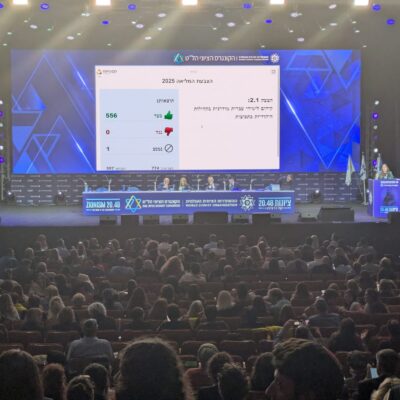Shift Happens | From Program to Platform

By Andrew Keene
As our organizations work in overdrive to emerge stronger from the Coronavirus pandemic, there is one final shift that I believe will catapult organizations toward long-term viability – a shift from program to platform. If you’ve been following the last three shifts, I see them building on each other in the following way: With an increasing shift from physical to virtual engagement, organizations need to engineer intentional and value-rich experiences understanding that people’s fluid expectations demand continuous improvement of these experiences, such that we create an immersive Jewish platform for engagement that works to fulfill our mission and purpose.
The word platform itself is ambiguous and the definition I’d like to use, adapted from the book Platform Revolution, is “an ecosystem that enables value-creating interactions between people.” This may sound simple but in actuality it is a radically different mode of operating. Plenty of organizations offer programs (or events, seminars, classes, services) that are often excellent experiences by every definition I used in the last two weeks. These programs create value, are innovative, and connect deeply to our Jewish values. But a program-orientation inherently relies on the organization to be perpetual creators, and because of fluid expectations, pressures organizations to continuously create better programs. A program orientation is in fact the opposite of a platform orientation. In a program, the value comes from what the organization provides. In a platform, the value comes from BOTH the ecosystem the organization creates and the interactions between people on the platform. Program participants are in “download” mode; platform participants are in “upload mode.”
We engage with platforms regularly without thought. Right now many of us are using Instacart, a digital supermarket platform that does not sell a single item. Unlike Whole Foods, the value comes from the seamless integration of grocery store inventory, AND the ability for someone without access to the store to connect with someone who can shop and deliver the groceries. Platforms do not allow for passive consumption, everyone is a co-creator of the overall value.
As Jewish organizations, we are often in the business of community, and communal organizations are by nature platforms! While you can join an organization, you cannot buy community, or pay more to get more community. Community is a platform that requires active participation – the more people that co-create the community, the larger and stronger the community is. Any rabbi, executive director, layperson, worship leader, or teacher, can alone create a program, but not a community because it is… communal.
The challenge is most organizations are tooled to curate a portfolio of programs and services that collectively can emulate a platform. This is partially a result of our current culture around funding – donors and philanthropists inherently fund programs where the format, engagement numbers, and outcomes are clear. We hire people to manage a set of offerings and they in turn create programs to demonstrate to our funders that they’ve invested wisely. This usually means our primary metric of success is registration (we often call this engagement, but we generally don’t actually measure levels of engagement). The shift from program to platform will require donors to fund the infrastructure and define ROI (return on investment) by how many value-creating interactions happen within that infrastructure, both between the professionals/clergy and community members but also between community members themselves.
Successful platforms benefit from the network effect – where great experiences compel people to bring their friends, which in turn creates an even better experience. People bring their friends when they understand their role on the platform (or in the community) and can fulfill that role without permission. Programs ask people to “sign up for something” whereas platforms ask people to “be part of something.” Platforms empower super-participants to be creators, allowing their work to be part of the open-source network of opportunities to engage with on the platform. In many cases our program staff are in fact the super participants but they can’t be the only ones.
Unlike programs that work to achieve a specific goal, platforms work to uphold a clear mission. Successful platforms have a vision for what the world will look like if it is wildly successful. The clarity of purpose and mission is what compels people to engage fully, although that engagement is not binary. The book New Power provides a nuanced model called the Participation Scale which suggests people engage with organizations in phases:
Sharing -> Affiliating -> Adapting -> Funding -> Producing -> Shaping
In a program-oriented organization, generally payment is due up front, engagement is optional. A platform orientation requires the organization to deeply understand where people are in this journey, fully appreciating not everyone will become funders, but those who do often provide outsize support. The value of the platform comes from the interactions between people across the Participation Scale, and the way we define and measure success needs to become more complex and rigorous to mirror people’s complex modes of engagement. The role of our professionals needs to evolve from exclusively creating programming to also creating intentional space AND opportunity for people to comfortably engage at each of these levels. If you’re following the logic, you are probably realizing that the membership model of most organizations is simply outdated, and not platform compatible.
The shift from program to platform, like the other three shifts, is happening around us whether we like it or not. Strong organizations will lean into these shifts in a way that captures the tailwind for growth. I worry that many organizations will lean away from these shifts and they will in turn succumb to the powerful headwind that these shifts create. Embracing these shifts has to start with bringing more diverse leadership to the table. Maintaining the status quo of insular leadership teams will not put us on the path towards change and I fear that organizations not willing to bring in younger leaders will miss the opportunity altogether to reimagine Jewish life in the post-Coronavirus era. To achieve the highest echelon of platform participation, we need to actively be asking, “how do we empower people to shape the future of our platform (organization).” There has never been a more compelling time for creating Jewish community, and never a more challenging time to experiment with the unknown. In many years time, I sincerely hope that the organizations we love and care about look back at this uncertain time as one that compelled bold change, inspired exciting innovation, and strengthened dynamic resiliency. Shift happens, it’s time to lead.
Author’s note- many people have reached out asking for books to read that complement the four shifts. I would highly recommend:
Platform Revolution by Geoffrey Parker et al.
New Power by Jeremy Heimans and Henry Timms
Good to Great by Jim Collins
The Lean Startup by Eric Ries
The Infinite Game by Simon Sinek
Andrew Keene is a member of the Management Committee of the World Union for Progressive Judaism and a member of the Board of Governors of the Jewish Agency for Israel. Andrew lives in Washington DC where he works for a consulting firm specializing in digital business transformation. He holds a business degree with a focus on entrepreneurship from Drexel University.

 Add EJP on Google
Add EJP on Google










